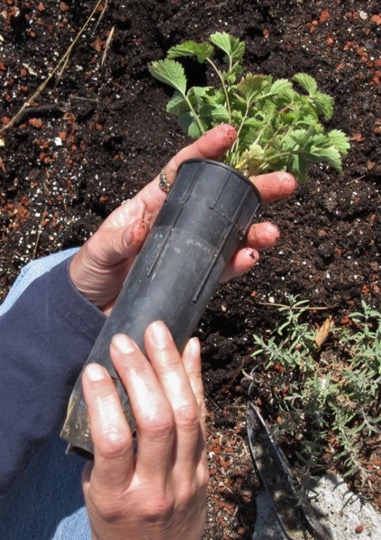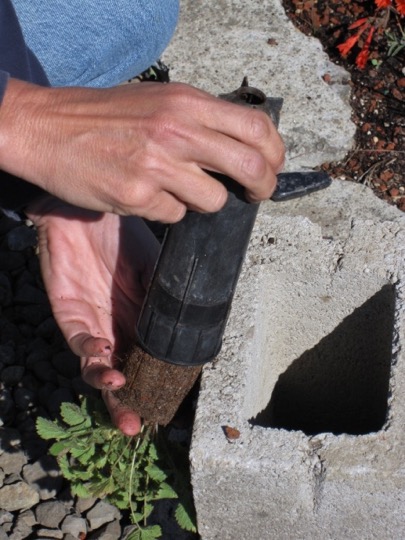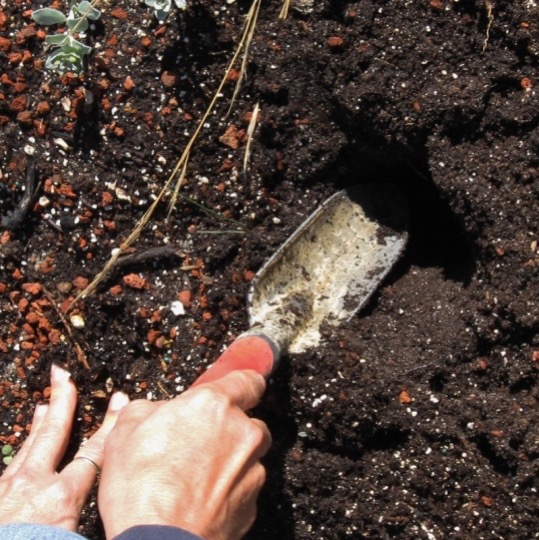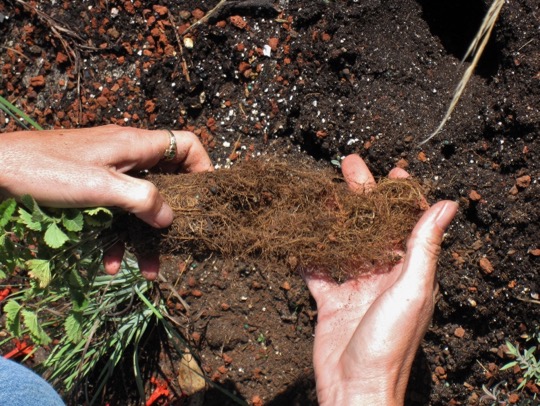Decide on the design or placement of your plants. Keep in mind the needs of the plants such as water and light as well as the mature size of the plants.
Prepare the soil:
California natives are adapted to native soil (including clay soil) and do not necessarily require soil prep at all. If you see fit, you can aerate your planting area with a shovel or trowel. If you want to go a step further, top dress your soil with a 1/2” to 1” layer of compost.
If you intend on planting into sandy/gravely soil, you will want to add a top soil mix (NOT potting mix). Local providers of top soil mix in the Richmond area are Acapulco Rock & Soil and American Soil & Stone.
Digging Hole:
Using a trowel, dig a hole slightly bigger than the size of the pot the plant is in. Be sure to contain the soil that you removed in a neat pile—you will need it again for planting. The goal is to have the plants roots grow into the native soil during the rainy season.

Remove plant from container:
Turn the plant upside down; hold the stem of the plant between two fingers, cupping the base of the plant.
Tap the edge of the tube on some hard surface and the plant should slide right out.

Planting into the hole:
First loosen up the root ball by gently “teasing” the roots loose—this will prepare them to spread.
Consider cutting the tips of the roots with a sharp pair of scissors to stimulate new growth.
Before planting, water your hole. Then, carefully place the plant into the hole, slightly higher than the surrounding soil, then backfill the hole with soil. It is not necessary to add any amendments or fertilizer; California native plants are adapted to native soil. Adding fertilizer is a bit like too much sugar for a child.
Watering in:
Water your plant in deeply. Your newly planted plants will need to be watered deeply, but infrequently until they become established. The first year check the soil down about an inch or two, once a week. If the soil is dry, water it. The second and third years, water if needed, during the months of November through April, and try to abstain from watering in the summer. If the plant originates from an area with similar rainfall patterns to your garden, you don’t need to water extra; if the plant originates from an area of higher elevation, you may need to water extra. For example, if you plant a redwood in Barstow, it will need extra water. If you plant a cactus in Eureka, it won’t need extra water.
Mulch:
Mulch can help keep away weeds, keep the soil moist longer and keep the roots cooler. Place mulch on top of the soil around the plant in a one to four-foot diameter circle. Keep the mulch away from the base of the plant as it could cause the crown if the plant to rot. Make sure to also include cleared areas of bare soil in your garden to provide habitat for ground nesting native bees.
Other Notes:
If you cannot plant immediately, be sure to check your new native plants daily to be sure the soil in the pot is moist and keep them in the shade. Potted plants can dry out quickly. Please try to plant within a week.


